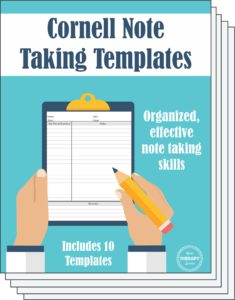How To Take Organized Notes
Do you work with students who need help taking organized notes? Do you have students who struggle with working memory? The Cornell Note Taking System can help you learn how to take organized notes. Students will not only take effective, organized notes, they can also study the material.

The Cornell method was a system created by Walter Pauk, an education professor at Cornell University, to provide students with a systematic format for condensing and organizing notes. The Cornell note taking style is often preferred by most people because it’s not just an acronym or a method, but rather its own way of thinking that allows students to remember more than they otherwise would.

How to Take Organized Notes Using the Cornell Note Taking System
Some suggest that the Cornell Note Taking System is the best way to organize notes. It is divided into several steps:
Step 1: Record Notes – Write notes in the note taking column on paper that is divided into different sections. See below to download your FREE copy of the template. Use short sentences or phrases for the notes.
Step 2: Key Points/ Questions – When the class period is over, write the key points or questions in the left-hand column on the paper. This step helps students to clarify meaning, strengthen memory skills and assist with studying.
Step 3: Recite – Cover the notes section and in your own words recite out loud the answers to the questions that you formulated in step 2. This step helps students with understanding the material and long term memory.
Step 4: Reflect – Think about the material you are learning to make connections with previous facts, ideas, and experiences.
Step 5: Review – Write a summary of the notes at the bottom of the page in your own words. Review all the material weekly to prepare for future tests.
Download Your FREE Organized Notes Template
You can click on the link below to get a copy of a sample page from the the 11-page packet of Cornell Note Taking Templates. A new tab will open with your freebie.
Need More Help with Note Taking?
If you want to get more information and help on how to take organized notes, check out the 11-page packet of Cornell Note Taking Templates.
Reference: Cornell University. The Cornell Note Taking System. Retrieved on 9/8/17 at http://lsc.cornell.edu/study-skills/cornell-note-taking-system/.
Read 10 more note-taking strategies.
More Organized Note Ideas
There’s no question that taking organized notes in school is easier said than done. There always seem to be distractions around when you try studying or focusing on something important for school or college exams . These distractions might come in many forms: loud classmates, notifications popping up on your computer screen while trying to finish an urgent task, etc. Sometimes your mind begins to wander, because you simply can’t concentrate…
Keep It Simple with Questions and Answers
This style can be used as an acronym for the words “Question”, “Answer”, “Topic” and “Notes”.
You start by writing the question at the top of your paper, followed by answers to this question written under it. The third element is the topic itself – write down some quotes or important pieces of information on that particular topic. Finally, write down your own personal notes below it all. This style allows you to learn more about a topic at hand and also makes it much easier for studying because you can associate questions with answers!
Organized Essay Note Taking
An organized essay writing style is based around the idea that every paragraph should be dealing with one topic only. The beginning sentence of each paragraph gives a general overview on what will be discussed in the upcoming paragraphs, while the last sentence encapsulates the main idea of that particular paragraph. You can apply this same style to note taking and studying for tests.
All you have to do is divide your paper into 3 columns: Topic Sentence, Concept 1 & Concept 2.
During class, the teacher goes over the topic sentence with students who ask questions if any exist or disagree with it. Then move on to Concept 1 where each point is discussed in detail by the teacher one by one until there are no more questions left. Finally, move on to Concept 2 where all those points from before are repeated but only briefly mentioned and summarized. This organized note taking method will help you to focus on the more important points of a lesson.

Do you work with students who struggle with organizational skills? Do large assignments or projects feel overwhelming and impossible? Some students benefit from explicit instruction on how to get organized. This digital download includes 7 worksheets to help older students learn how to get organized and tackle big projects. FIND OUT MORE.
The Outlining Method
The Outlining Method, using dashes or indents, can be very helpful and simple way to organize notes. The information which is most general begins at the left with each more specific group of facts indented with spaces to the right. No numbers, letters, Roman numerals are required; these relationships between different parts are carried out through indenting. Place major points all the way to the left hand side of the paper and indent each more specific points below and to the right.
Mapping Method
Mapping is a method that helps you understand what’s going on by breaking down the information into smaller pieces and putting them in order. It allows students to see how one fact relates to another, which means they’re more likely to remember it all later! An example of a mapping method is using graphic organizers.
Graphic organizers helps students understand material better by organizing topics and noting connections between them. It uses comprehension/concentration skills, evolves in a note-taking form which relates each fact or idea to every other fact or idea, and maximizes active participation so students will gain immediate knowledge as to its understanding. Mapping also emphasizes critical thinking because it encourages the student’s ability to analyze information for pattern recognition.
Summary on How to Take Organized Notes
Keep in mind that every student learns differently. Discuss, review and test out all the different options for note taking to help determine what will work best for each individual student. Remember this skill needs to be taught to students.





